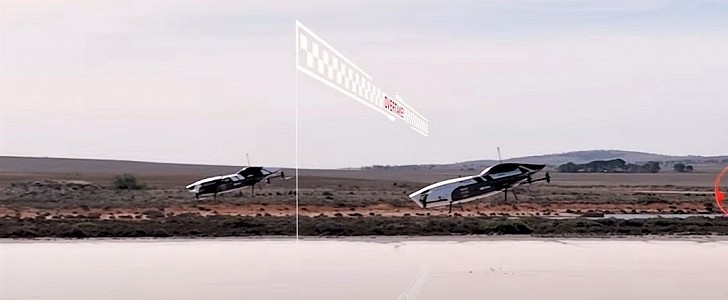Airspeeder kicked off its EXA series of remotely-operated races. For the first time, two pilots were given full license to race their flying cars blade-to-blade around a digital sky-track circuit above the pink salt flats of Lake Lochiel near Adelaide, South Australia.
The historic moment offered a glimpse into the future of motorsport and urban air mobility (UAM). We're seeing for the first time a competition taking place in the sky with two 4.1-meter-long (13.4-ft-long) eVTOLs. This milestone comes after more than 270 test flights in which the aircraft technology was thoroughly assessed.
Airspeeder pilots also spent thousands of hours of training in the simulator for the world's first flying electric car race. Zephatali Walsh was the virtual pilot for the team silver racer, while Fabio Tischler was in charge of the black team's aircraft.
The eVTOLs, two Mk3 flying race cars, raced in the sky over a 1 km (0.62-mile) digital track. The competition was comprised of two sessions that were shortly interrupted by rapid battery-swap pitstops. During the first session, team black's flying car reached a top speed of 102 kph (63.3 mph) and clocked a lap time of 0.39 seconds. Team silver's aircraft was a bit slower. It was able to clock 0:44 seconds and fly at a 99 kph (61.5 mph) top speed.
After losing speed on exit, Walsh controlled the eVTOL to fly a meter (3.2 ft) below Tischler's race-craft. This maneuver secured the team silver's victory. Walsh won with a circuit time of 0:39 seconds and hitting 100 kph (62.1 mph), while Tischler marked 0:43 seconds at a speed of 99 kph (61.5 mph).
This historic race offered just a taste of EXA Remotely piloted races. In the future, more pilots will join the competition, including Bruno Senna, former F1 and World Endurance Racing star. And that's not all. The races will be set in a wide range of locations where racing was never seen before.
All remotely-piloted races that will follow will serve as the stepping stone for the Airspeeder Grand Prix crewed series that is expected to take place in 2024.
Airspeeder pilots also spent thousands of hours of training in the simulator for the world's first flying electric car race. Zephatali Walsh was the virtual pilot for the team silver racer, while Fabio Tischler was in charge of the black team's aircraft.
The eVTOLs, two Mk3 flying race cars, raced in the sky over a 1 km (0.62-mile) digital track. The competition was comprised of two sessions that were shortly interrupted by rapid battery-swap pitstops. During the first session, team black's flying car reached a top speed of 102 kph (63.3 mph) and clocked a lap time of 0.39 seconds. Team silver's aircraft was a bit slower. It was able to clock 0:44 seconds and fly at a 99 kph (61.5 mph) top speed.
After losing speed on exit, Walsh controlled the eVTOL to fly a meter (3.2 ft) below Tischler's race-craft. This maneuver secured the team silver's victory. Walsh won with a circuit time of 0:39 seconds and hitting 100 kph (62.1 mph), while Tischler marked 0:43 seconds at a speed of 99 kph (61.5 mph).
This historic race offered just a taste of EXA Remotely piloted races. In the future, more pilots will join the competition, including Bruno Senna, former F1 and World Endurance Racing star. And that's not all. The races will be set in a wide range of locations where racing was never seen before.
All remotely-piloted races that will follow will serve as the stepping stone for the Airspeeder Grand Prix crewed series that is expected to take place in 2024.











